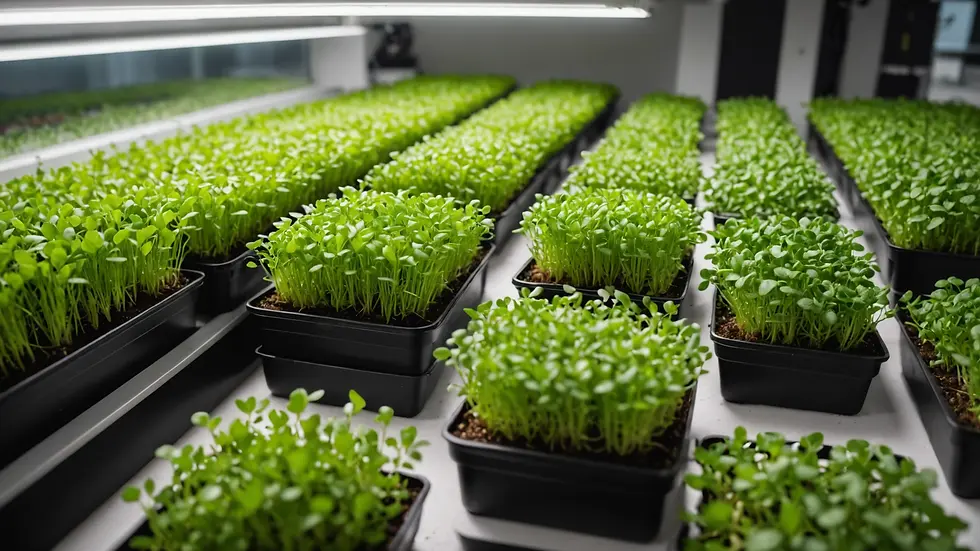Uncovering the Power of Microgreens: A Look into the Benefits and Growing Industry of Specialty Produce
- Matthew Bowser
- Feb 21
- 4 min read
Microgreens have captured the culinary spotlight, appealing to health enthusiasts and top chefs alike. These small greens are flavorful, attractive, and incredibly nutritious, making them a fantastic addition to any meal. Whether sprinkled over salads or blended into smoothies, microgreens can elevate your dining experience in numerous ways.
As the demand for healthy and sustainable food rises, the microgreens industry is thriving. With more people seeking organic and nutrient-dense options, microgreens have established themselves as essential ingredients in both homes and restaurants dedicated to promoting health and wellness.
What Are Microgreens?
Microgreens are young plants harvested just after their first true leaves, also known as cotyledons, have developed. These tiny greens span a variety of tastes and textures, including the peppery kick of arugula and the sweet notes of basil. They typically grow to be about one to three inches tall and can be cultivated from many different plant varieties, such as herbs, vegetables, and even some grains.
One of the standout features of microgreens is their versatility. These greens seamlessly blend into a wide range of dishes, adding not just flavor but also visual appeal without extra calories.
The Nutritional Benefits of Microgreens
Microgreens are often celebrated for their impressive nutrient levels. Research has shown that they can contain up to 40 times the nutrients of their mature counterparts. Here are some specific examples:
Vitamins: Microgreens like kale and broccoli are abundant in vitamins A, C, and E. One ounce of broccoli microgreens can provide over 30% of the recommended daily intake of vitamin C, which is vital for immune support and skin health.
Antioxidants: The bright colors of microgreens suggest high antioxidant levels. For instance, red cabbage microgreens have potent antioxidants that assist in fighting oxidative stress, thereby reducing chronic disease risks.
Minerals: Microgreens such as sunflower and pea shoots offer important minerals like calcium, iron, and magnesium. For example, just an ounce of pea shoots can furnish 15% of your daily calcium needs, which supports bone health.
Integrating microgreens into your meals can markedly boost your nutritional intake while introducing delightful flavors.

Microgreens and Their Impact on Health
Eating microgreens contributes positively to overall health in various ways:
Supports Digestion: Being high in fiber, microgreens aid in digestion. A healthy gut is crucial for proper nutrient absorption, influencing overall well-being.
Low in Calories: For those aiming to maintain or shed pounds, microgreens are an excellent choice. A generous serving can be added without significantly increasing calorie intake, making them ideal for weight-conscious individuals. For instance, an ounce of mustard microgreens contains about 5 calories.
Reduces Inflammation: Some studies have found specific antioxidants in microgreens can lower inflammation. For example, compounds in radish microgreens may help reduce the risk of developing heart disease and diabetes.
Boosts Flavor: With their concentrated flavor, microgreens enhance the taste of any dish. They offer a delicious alternative to heavy dressings and sauces, making it easier to enjoy healthy meals.
Incorporating microgreens into your diet can enrich your meals and provide numerous health benefits.
The Microgreens Industry: Growth and Sustainability
The rising popularity of healthy food choices has fueled substantial growth in the microgreens industry. Specialty produce farms are popping up everywhere, supplying fresh microgreens to grocery stores, restaurants, and farmers' markets.
Sustainability drives much of this growth. Microgreens require significantly less land and water compared to traditional crops. For example, a vertical farm can produce 1 ton of microgreens in just 5% of the space required for conventional farming. This approach allows for year-round growth and helps reduce the environmental impact of transporting food long distances.
Moreover, many microgreens can be cultivated in urban settings, which minimizes the supply chain and brings fresh greens directly to consumers. With busy schedules, health-conscious eaters find it easier than ever to access these nutritious foods.

How to Incorporate Microgreens into Your Diet
Start enjoying microgreens easily with these practical ideas:
Salads: Use fresh microgreens as a base or topping to enhance salads with flavor and vibrant color.
Wraps and Sandwiches: Swap out regular greens for microgreens in wraps and sandwiches for a nutritious twist.
Smoothies: Blend a handful of microgreens into your smoothies. They boost nutrient content without altering the taste.
Soups: Add microgreens to soups as a fresh garnish, bringing new flavors that complement various broths.
Garnish: Sprinkle microgreens atop any dish to elevate its presentation and taste.
Incorporating microgreens into your meals not only improves your health but also enhances the overall flavor and aesthetic appeal of your cooking.
Embracing the Microgreens Movement
The thriving microgreens industry offers an exciting opportunity for anyone eager to enhance their diet with healthy, flavorful foods. By adding microgreens to your meals, you tap into their impressive nutritional value while supporting sustainable food practices.
Joining the microgreens trend is a commitment to better health and wholesome eating. Whether you are a busy parent, a working professional, or simply someone who values quality food, consider making microgreens a regular feature in your diet. Embrace the benefits of these tiny greens and observe the positive difference they can make in your health and wellness journey.






Comments